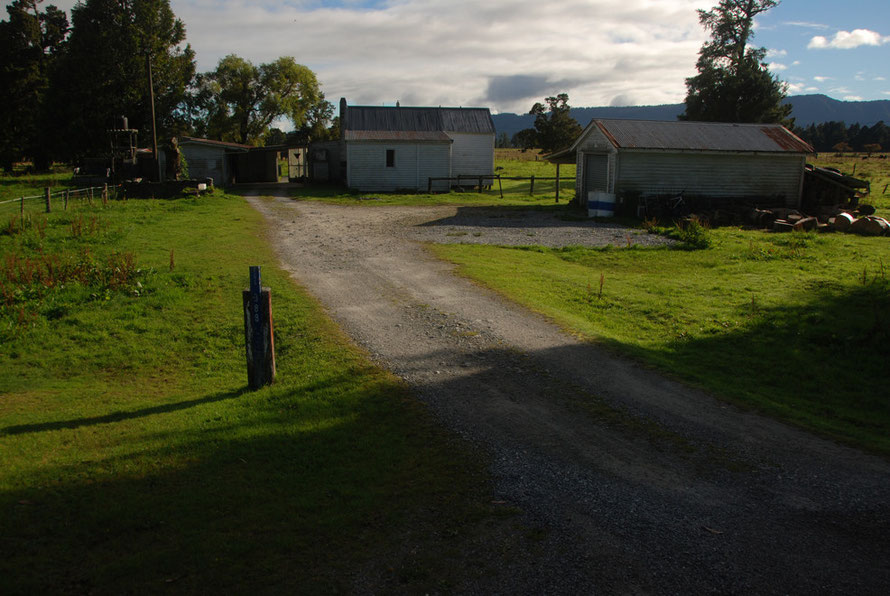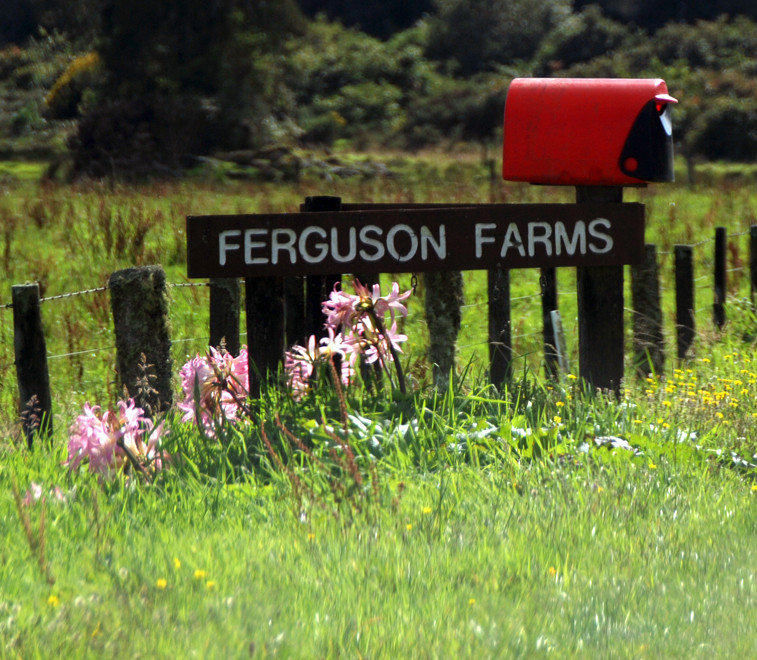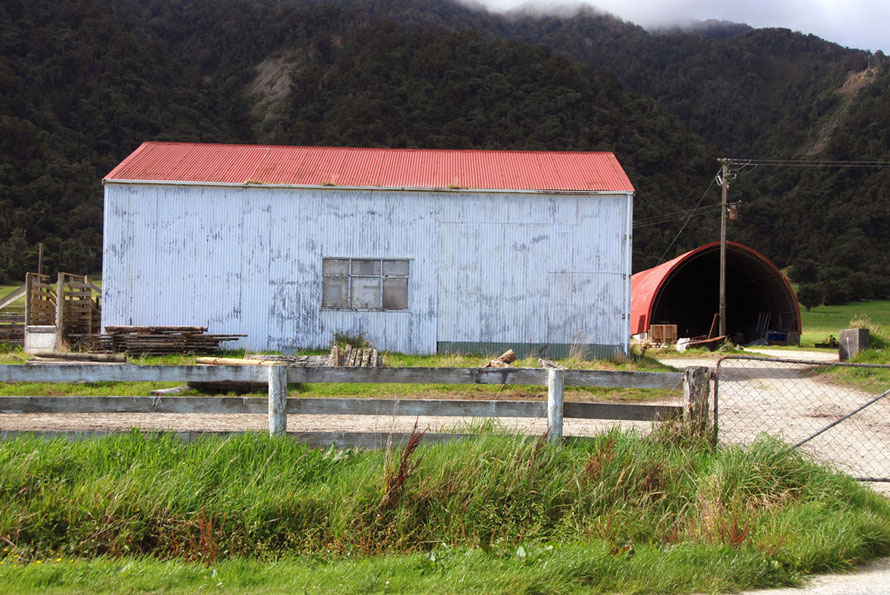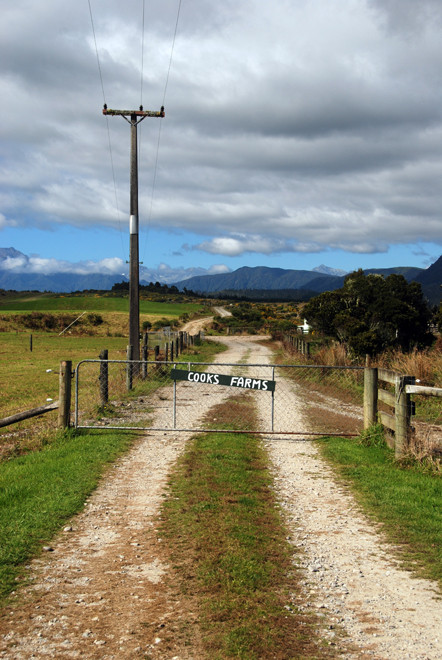Ferguson Farms: a name's a name for that

For some reason to me New Zealand felt liked a missed destiny, somewhere, but for a thousand other life chances, that I'd come to too late.
It's all ridiculous speculation and a fantasy to want to play time's arrow ('arrows' - game of darts) again. But it nagged at me. Pulled at my heart. Even.
Instead of heading for Dunedin, my great-great-great-Scottish grandfather and grandmother had left Dalry in Dumfries and Galloway and sailed to America and lived in New York and through the generations moved out to Plainfield, New Jersey ending up on the pine-clad, granite shore of Naskeag Point near the small town of Brooklin (pop. 824) in Hancock County at the northern end of Maine not far from the Canadian border.

Of course, to pin my forward trajectory on one set of great-great-great-great grandparents is to ignore the other fifteen and to favour my father's 'blood line' over my mother's.
But that harking back to Scotland was also bound up in the name with which they had thought in their wisdom to bequeath me - a 'Yank' boy living in a rural East Anglian village.
In its full glory they named me, 'Ferguson Morton Murray'. Someone had to honour all those old family names and three fell on my shoulders and into my birth certificate.
At the best of times those three surnames were hard to love. But back in the 1950s 'Fergus' as a Christian name was rare outside of Scotland and Ireland. And 'Ferguson' was unheard of. And still is.

(See the screenshot below from the Wikipedia page for Ferguson. Only four people are listed with a given name of Ferguson - and one of them is fictional. But I am pleased to be amongst such illustrious company.)

People were forever getting mixed up with my chicken and egg, my 'Ferguson' and 'Murray'. Not surprisingly because 'Murray' has a bit of a history as a given or Christian name.
Clearly someone was not thinking these things through back in 1957.
Perhaps this is how it went,
'Hey guess what. We'll call our second born 'Ferguson' - a common surname but very rare - to the point of not existing - as a Christian name. That should work really well with a surname like 'Murray' that's been used enough as a Christian name to merit nine pages (207 entries) on the 'Who's dated who' website under the rubric 'Celebrity First Name - Murray'.
'But hey before we decide let's just have a look to see how many celebrities have 'Ferguson' as a first name. I'll just fire up the Tardis (even though Dr Who doesn't start until 1963) and shoot forward to the internet age. Back in a tick.'
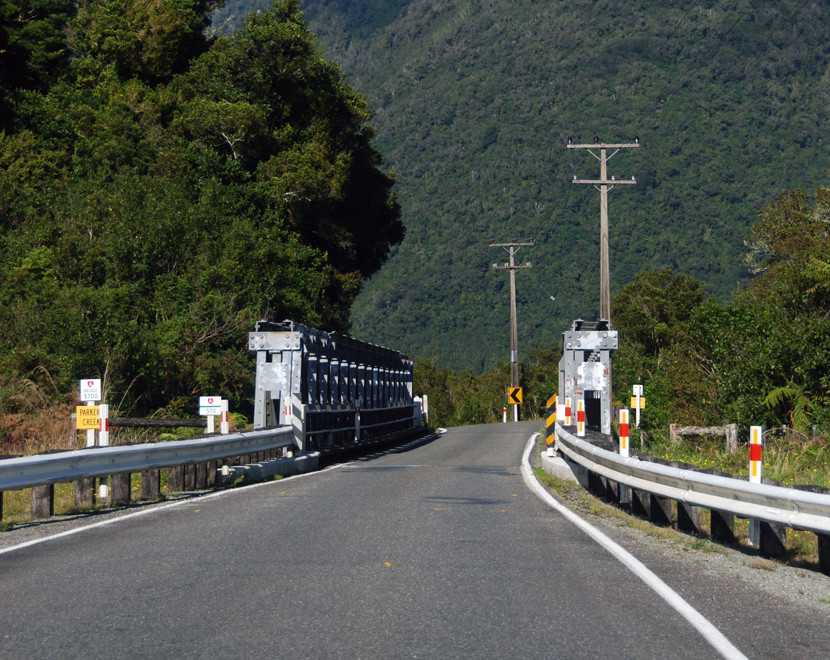
(An interval follows.)
'Wow. That internet thing is fantabulous. There are 44 celebrities with the first name 'Fergus' (although there are more with 'Ferenc'). And 'Ferrin','Ferzan' and 'Fess' each have two celebs, and poor old 'Fergal' has eight. But 'Ferguson' has none. It doesn't even figure. It doesn't get a mention.'
'How fantabulous. So we'll call him Ferguson Murray.'
(Because somewhere back in the mists of time there was someone called 'Mary Ferguson' - who search though I might I have never been able to find in the genealogy).
'Oh, and while we're at it lets saddle him with the middle name, 'Morton'.'
(From 'Esther Morton-Smith' and a revolutionary Philadelpia banker who used to bury a hock of bacon in his garden to escape Johnny Redcoats' requisitions, apparently).
'That should really set him up for the life we are leading in good olde England. He's only small but I'm sure he'll cope. But I suggest we don't print it all on a soccerball shirt just yet.'
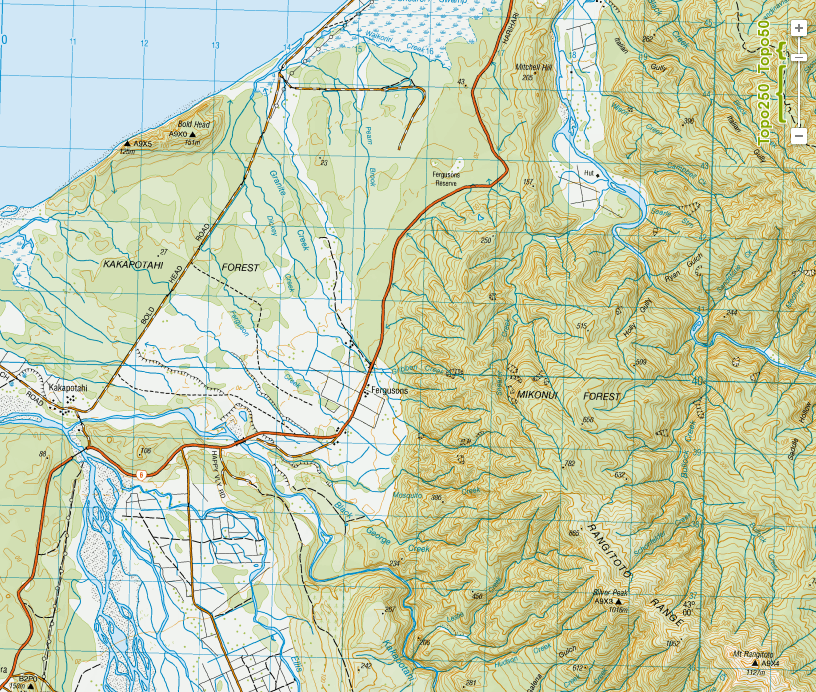
I went through my childhood carrying my first name gingerly like a bag of American sweets ('candies') you really don't care to share. And I thought it was my fault that I was embarrassed. And that my embarrassment somehow was unfair to my parents in that weird world where children are at fault and have to make amends for things over which they have no control.
When I eventually shortened the name to 'Fergus (which frankly was not much easier in 1980s Southern England) I felt as if I were cutting a piece off my parent's history even though the 'Mary Ferguson', after whom I was supposedly named, may have never existed in the first place.
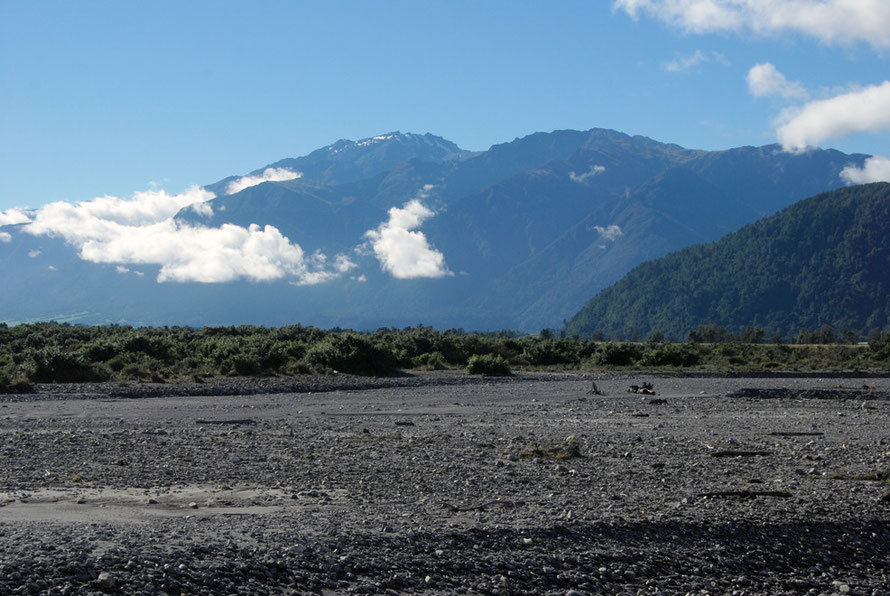
For some strange reason going to New Zealand seemed to offer some hope for my name. This flame of redemption and belonging flickered somewhere in my sub-conscious. I don't know why. But there it was.
Maybe because, as Crosbie Wells says to his half-brother in a letter in Catton's The Luminaries (2013 p.473),
'every man [in New Zealand] has left his former life behind and every man is equal in his way.'
Or because, as I read somewhere else (but now can't track down), that New Zealand is a forgiving country where a man can fail and start again without shame.
Or maybe because so many Scots had gone to New Zealand that my name would somehow have a positive currency amongst the caber tossing, kilt wearing brethren of the South Island.
Anyway, driving north from Fox Glacier on State Highway 6 up the West Coast I brought the car to a sudden and hard stop. I pushed the stick shift into reverse and revved backwards careless of the almost non-existent traffic.
Earlier we has crossed the Waiho River that runs from the terminus of the Franz Josef Glacier to the sea, stopped for petrol in Whataroa and crossed three more short and fast braided rivers running down from the magnificent Southern Alps.
The sun was shining brightly, the sky was a deep iridescent blue and snow-capped peaks and high plateau glaciers showed between the thickly-wooded and vertiginous ranges in front of the Alps proper.
I'd taken a photo of a dog sitting on an abandoned armchair on a villa porch and one of the woman running the garage at Whataroa and any numbers of snaps of mountains, rivers, trees and the brilliant greens of the 'flats' between the mountains and the Tasman Sea.
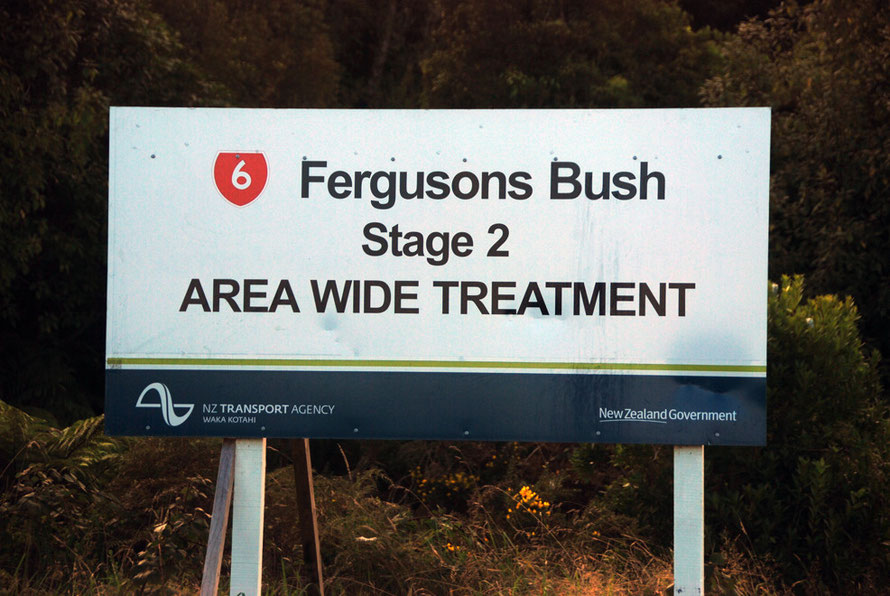
I'd come to such a juddering halt and gained 'The Principal's' approbation because in thick forest a sign had caught my attention. It said in a big official-looking font, 'Fergusons Bush Area Wide Improvement Stage 2'
At the top left was a bright red shield with the number six in white for State Highway 6. On the bottom stood the logos - white on a cobalt blue banner - of the New Zealand Government and the NZ Transport Agency/Waka Kotahi.
There was no apostrophe in the 'Fergusons', which was a shame, but it was funny enough as it stood with the bush/beaver/ innuendo that seemed to be cast in my personal direction. I thought to myself, 'How wonderful not only to have a bush named after you but to also have a bush that merits two stages of area wide improvement'.
Which reminded me of that joke:A woman goes into the bar and asks for a double entendre. So the barkeeper gave her one. Boom. Boom. I took a picture and we moved on.
(In passing, the contract price for the first phase of the Area Wide Improvement was $756,479.74 and for Stage 2 it was $549,408.30 - a total of $1,305,888.04. Which seemed quite a lot of money to spend on bush, to whomsoever it belonged. I wondered what that 4 cents at the end of the total cost was to be used for.)
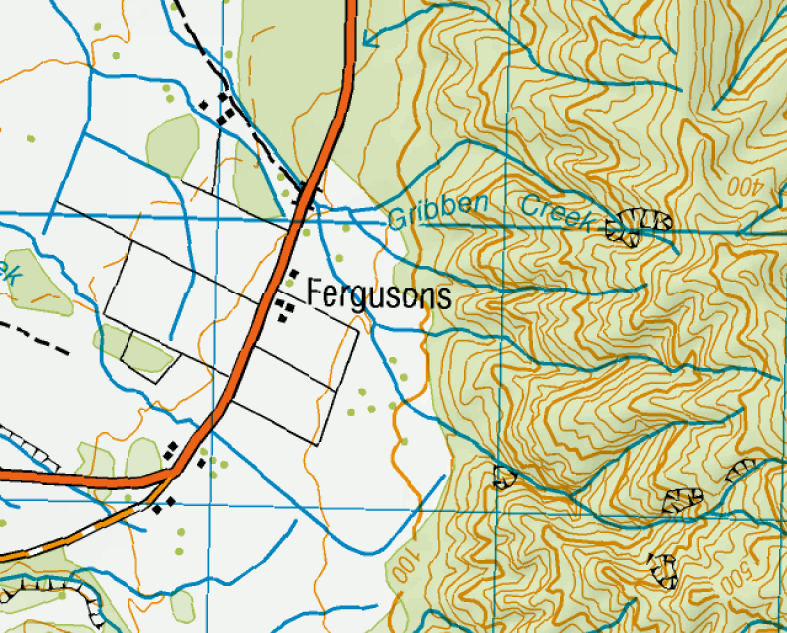
Then shortly afterwards we'd passed a bright black and red letterbox, red-oxide tin buildings and a modest bungalow set behind to raised circular concrete tanks. Again I slammed on the anchors and backed up, grinding the gearbox on the way. And there was another sign. This time saying 'Ferguson Farms'.
What a lucky day this was turning out to be. I took three photos from the car so moved was I. It was all there. The flickering blue light had burst into flame.
This was the emigre's dream, the settler's vision of heaven. Not 'forty acres and a mule' - the famous and betrayed settlement for freed American slaves - but (as I later learned after fruitless
searching on the internet) 120.9 hectares and a dairy herd with a land valuation of NZ$1.275m (£640,000), a capital valuation of NZ$1.5m and an annual rates bill of NZ$2281 (£1,147) (Westland local government site).
Here was a farm by the side of the road with fine looking pasture-land cleared from the Granite Creek Flats. Its land backed up to the Rangitoto Range that seemed to leap vertically from the coastal plain. And yet the steep slopes were covered in a dense growth of native trees - part of the Mikonui temperate rain forest.
The ridge behind the house topped out at Silver Peak (1016m) and then climbed further to Mt Rangitoto (1127m). Beyond this Dickie Ridge, Sawtooth Edge and the Bloomfield and Lange Ranges rise to the peaks, snowfields and glaciers of Park Dome (2340m), Mt Evans (2620m) and The Red Lion (2444m).
Fast flowing streams run off the steep hills and water the land - if it were ever required in a place of such prodigious rainfall - and yet the homestead is safe from them.
My mother had a piece of embroidery that said, 'Let me live in my house by the side of the road and be a friend to man.' This farm and this land in its modesty and its grandeur, tucked into the hills and away from the flood-prone torrents, seemed to me to be such a place and it bore my name.
(The phrase is a poem by Sam Walter Foss (1858-1911) called, The House by the Side of the Road.)

As a teenager out of sorts with, and petty scared by, the world I'd thrilled to the name of books such as 'I Bought a Mountain' and 'A Place of Stones' (both by Ruth Janet Ruck). I'd devoured and held close My Side of the Mountain (by Jean Craighead George), the tale of the boy living in a hollow tree in the Catskill Mountains. I'd fantasised about leaving school at sixteen when the world became a place of repetitive and gnawing anxiety and living on a lonely sheep farm with only the wind and rain (and sheep, obviously) for company.
They were dreams driven by necessity that had no hope of realisation. I wrote to E. F. Schumacher (Small is Beautiful) asking him what I should do as my 'A' levels ended and I waited helpless to be tied further into a world of double-binds and bloodknots.
He kindly replied suggesting university and then see. Which was too long for me but I went unwillingly. And all the time, all that time, this farm, Ferguson Farms, with its hint of Ferguson 'doing' rather than 'dreaming', had been here amongst its rushing streams and wind-tossed forests.
The settlers dream. The pioneer's story. For me it was not freedom from want nor the space to be 'equal' that drove my dreams.
For me it seemed to be about getting out of institutions of learning and a middle class (and a family I later realised through years of therapy, of course) where I felt hemmed in, observed, judged and prepared for The Fall.
And all the time that I was dragging my sorry ass from pillar to post, Ferguson Farms, with its red pick-up, concrete tanks and low-tiled roof had sat here on the West Coast of the South Island of New Zealand.
I hope it fulfilled someone else's dreams, with all the heartache and uncertainty of the settler, with all the terrifying effort and loneliness of 'breaking in the land', with all the distance from the old world and the strangeness of the new, and the compromises, powerplays and outright expropriations made between Pakeha and Maori.

Returning home when the photos came into focus out of the mass I searched for news, for history, for something about Ferguson Farms. While, you might say, it was all the time here inside of me. I could find nothing and maybe that is for the better. It is not my place and it was a jolt in passing that set me thinking.
But then in my searches I did come across a sale advert for a 'perfect entry level farm' further along State Highway 6, not far
from Ferguson Farms. It comprised a three bed house, 102ha with 190 milking cows with a projected output of 90,000kg of MS (milk solids), sheds and plant all in for $3,266,450 plus GST (Goods and
Services Tax) if any.
!['Let me live in my house by the side of the road and be a friend to man [and woman]': Southern Alps view between Ross and Hokitika](https://image.jimcdn.com/app/cms/image/transf/dimension=890x10000:format=jpg/path/s43f928e84fd05874/image/iab8152d7cb826c4e/version/1409256302/let-me-live-in-my-house-by-the-side-of-the-road-and-be-a-friend-to-man-and-woman-southern-alps-view-between-ross-and-hokitika.jpg)
But it is not farming in the abstract that appeals. It was that name, with its defiant crie de coeur that said, 'Ferguson farms and he farms well' that touched and stirred my heart.
I raise a glass to Ferguson Farms and all those who have lived there and will live there and drink a 'planxty' to them*.
So its now to conclude and to finsih my ditty
If ever passing Irishman should pass my way
With the best in the house I will treat him and welcome
At home on the green fields of Americay.
With my great friend and mentor, Bob, swaying saying,'But now wait for it. Those pipes, those pipes... '
and Liam O'Flynn would come in on the uillean pipes.
* "Planxty" is thought to be a corruption of the Irish word and popular toast "sláinte", meaning "good health."

Postscript: Fergusons Bush Devastated
A little over two weeks after we passed through Fergusons Bush it was hit by a titanic gale on April 17th 2014.
The Greymouth Star of May 3 2014 reported:
'Lifetime resident Jim Ferguson - whose grandfather and Westland County councillor set aside Fergusons Bush over a century ago - said the highway was now a bit of an "eyesore'', though it would regenerate. Big pockets were left where all the trees had fallen over.' ...
'"It felled a lot of old trees,'' he said, many of them rimu [some of which were thought to be 600-700 years old]. Mr Ferguson said he had to look after himself in the wind, as limbs fell down around him.' ...
Newer trees planted on his farm, which were 60 or 70 years old, also tumbled in the wind, though his corner was more protected.
It's sad when the wind wreaks such devastation and from accounts it was unusual in its ferocity and betokens the predictions of climate change impacts on the Southern Alps - more wind and more
rain. I was heartened that Jim Ferguson's 'corner was more protected'.
My thanks to Randall McMullan, another man saddled with a surname up front, (at pianobeach.com on Auckland's west coast) for bringing this article to my attention.
Postscript II: Samuel Ferguson (1848-1923)
Armed with more specific information on the Ferguson Farms my internet searches bore more fruit.
![Information on one the founding Fergusons from County Derry, Irealnd from the The Cyclopedia of New Zealand [Nelson, Marlborough & Westland Provincial Districts] (click for link)](https://image.jimcdn.com/app/cms/image/transf/dimension=590x10000:format=png/path/s43f928e84fd05874/image/i498a0d1629906d77/version/1407938172/information-on-one-the-founding-fergusons-from-county-derry-irealnd-from-the-the-cyclopedia-of-new-zealand-nelson-marlborough-westland-provincial-districts-click-for-link.png)
A further entry under 'Ferguson's' (with the apostrophe) is found in the Cyclopedia.
Further investigation led me to this Fergusons of Derry (Londonderry) page with no mention of Samuel George Ferguson. There is a farm labourer, Robert Ferguson of Ballybriest, in the ship's passenger lists who leaves from Greenock, Glasgow on 4th May 1870 for Port Chalmers, New Zealand on the wooden barque, Edward P Bouverie.
The Edward P Bouverie was an Aberdeen built sailing ship (1864) that ran regular trips to New Zealand between 1864 and 1871. The Glasgow Herald of October 1867 described the ship:
This splendid passenger ship sails very fast and has elegant poop accommodation for cabin passengers with plunge baths and lofty and well ventilated tween decks for steerage passengers. A duly qualified surgeon will accompany the ship.
The trip time was in the region of 95 days. In 1880 returning from Java with sugar for Falmouth the Edward P Bouverie struck on a rock at Rozel near Cherbourg and foundered. 'The whole of the crew, 30 in number, are supposed to have perished.'
The British Consulate at Cherbourg reported on 5/3/1880:
'the barque fired guns and distress signals and the cries from on board were distinctly heard, but unfortunately there were in that locality no boats or any means of rendering assistance. It is said that rockets and lights were seen about 7pm... they are supposed to have been from the barque. She struck at about 9.30pm, when the cries of those aboard, and until about 10 o'clock or thereabouts, when all lights disappeared, and it is evident that at that moment the vessel must have broken up... 7 bodies have been washed ashore, all of them fine able-bodied men, apparently seamen... several of the seamen were supported by lifebuoy - one in the posture of swimming. But none could be resuscitated... nothing to indicate that Captain Evans's body was among them'.
(For the Edward P Bouverie see Aberdeen Ships).
The Fern Grove Hotel
The 'accomodation house' at Ferguson's referred to above was known as the 'Fern Grove Hotel' according to a Westland Publicans (1920s) genealogy page. Samuel Ferguson applied for an Accommodation Licence in 1904 (Papers Past) and was nominated for a councillor for the South Riding of Westland County Council in 1905 (Papers Past).
Land and Cattle Disputes
In 1889 Ferguson claimed £19 3s for damage caused to some of his cattle through impounding by a John Allen (Papers Past). There had been earlier issues with John Allen and others over a lease of a run that had not been registered with the Land Board. These were heard at Hokitika Supreme Court in 1884. The suit was successful (Papers Past).
Previous to this Ferguson had been accused of killing a cow by John Allen in 1882. The case was heard at the Hokitika Supreme Court in 1883 where Ferguson and his co-defendant, James Dunlop, were referred to as 'the prisoners'. The detailed account of the case makes for fascinating reading.
A cow was apparently shot on the 10,000 acre run of John Allen and his co-owners. Ferguson and Dunlop were accused of the deed. Their houses were searched by the police for fresh beef and hides. The knuckle from a quarter of beef at Dunlop's house was used to suggest a linkage between the beef and the shot cow's feet (which were found in the bush where it had been killed).
In his deposition Allen mentions a case two years earlier between himself and Ferguson that Ferguson had won. According to the press report of a police witness, Constable Watson, Ferguson admitted the cow had been shot but not by him. Again, according to Watson, he was on the point of taking the police to find the hide left in the bush when he changed his mind and, 'said he would not go, because he did not like to leave his wife, when they were so many Chinamen about.'
Thomas Ferguson, Samuel's brother, was called as a defence witness. Thomas and Samuel held the Happy Valley run of 5,000 acres in common. This adjoined Allen's run.
Patrick Gribben, a station owner, had sold Happy Valley to the Fergusons. The press coverage states that he commented, 'I have often known quiet cattle disappear among wild cattle and not be recovered for months'. At this point the judge is reported as observing that, 'ladies were sometimes fickle'.
The court case ran onto the evening and the night. After prosecution and defence summaries and the judge's address the jury retired at 10.15 pm. They returned at half past twelve midnight and delivered a 'Not Guilty' verdict and the judge discharged the prisoners (Paper Past: 6 April 1883 West Coast Times).
If nothing else the account of the court cases between Samuel Ferguson and John Allen suggests there was a serious feud between the men. The defence in the cattle stealing case asserted that this was due to jealousy at Ferguson's success on the part of John Allen.
It would be an odd thing to accuse a man of stealing a cow worth £7 when cattle runs were huge and fencing was rudimentary or non-existent if there were not bad blood involved.

In 1901 Ferguson applied for 100 acres of Waitaha under the Midland Authorised Area Land Settlement Act 1990 at 15s (£0.75) per acre. His application was granted (Papers Past). This Act released over 6 million acres of land that had been reserved for the Midland Railway.
A branch railway line was built from Greymouth to Hokitika and completed in 1893. An extension to Ross further south was built and completed in 1909. Plans had been drawn up to continue the branch further south, possibly to go over the Haast Pass and to Wanaka but this never happened. The Ross line was closed in 1980.
A bush railway ran 20km south from Ross nearly to Lake Ianthe/Matahi. This was used for logging and was owned by Stuart and Chapman Ltd. It closed in 1959 (see Wikipedia: Ross Branch).
The Hokitika to Greymouth line has but one seasonal freight train a day carrying out products from the Westland Milk Products plant.

Samuel Ferguson died of heart failure in Sydney aged 75 on a 'health trip' to Australia in 1923.
His death was briefly noted in the West Coast Notes, the Auckland Star and the New Zealand Herald where he was remembered for being chair of the County Council on two occasions and a councillor for many years (Papers Past).

